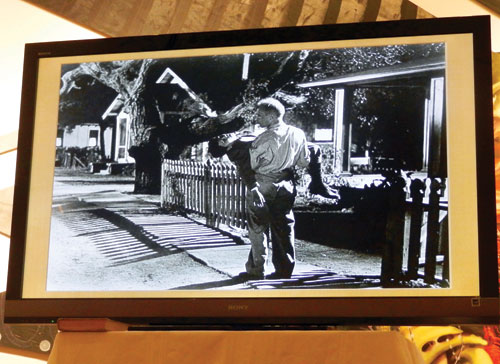
In an extremely personal lecture on Oct. 3, the Triton Museum of Art’s Chief Curator Preston Metcalf, took guests on a journey to the deep south – Maycomb, Alabama – to discuss the impact of Harper Lee’s To Kill a Mockingbird.
“What we’ll be doing tonight is that I’m going to give you a discussion about the book, my take on it and at the same time we will be looking at some of the art that comes at the same time and a little bit after,” said Metcalf. “We’ll be looking at the themes. How the same themes that are included in To Kill a Mockingbird, and that are addressed in To Kill a Mockingbird, are also to be found in the visual arts.”
Metcalf gave an overview of the book’s plot and delved into its themes – racial injustice, the loss of innocence, courage, and compassion – talked about how society, notably what was happening with the civil rights movement, inspired Lee to write her renowned novel, and how Lee’s novel, in turn, helped inspire the art of the era.
“After 1960 a new art is born. Art of the civil rights era…I’ve picked a couple of pieces by this artist, Faith Ringgold, who came to prominence in this time period. After the publication of To Kill a Mockingbird, and the attention that was now being paid to race relations, Faith Ringgold now starts creating works such as…’Die.’ [In the painting] you have the race riots. You have white people killing each other, black people running – dying, a naked white woman screaming. You have two kids here – white and black – clutching each other in absolute fear. They are the future and they’re afraid. Those two kids, that’s us. So this is the new art that’s born. It’s powerful. It’s raw. It’s serious. It’s painful. It’s ugly and it’s important. And, it’s great.”
Reading excerpts from the book, showing images of art, and sharing personal stories that moved many to tears, Metcalf’s lecture was among the best he’s ever given. Just like in visual art, where each piece is about the viewer, Metcalf stressed that literature isn’t about the characters, but the reader.
“You want to know what this is about?” said Metcalf. “It’s about you. You are Scout. You are Boo Radley. And, if you can die to your selfish being and you are reborn like Scout into a compassionate being, then you will become Atticus Finch. That’s the promise of this book. Great literature and great art are about ideas. The greatest idea is always, always, always the same. That we are all connected. We are inseparable. I am my son. I am Scout. I have tried to be Atticus. I am my friend. I am my enemy. I am the poor individual that I don’t know – that screams in pain or laughs in joy…That is the message of To Kill a Mockingbird.”
On Thursday, October 10, Metcalf will take a look at how Dante’s Divine Comedy marks the beginning of Renaissance thought in Europe. Lectures begin at 7:30 p.m. Drop in fee is $20. Visit www.tritonmuseum.org for more information.





